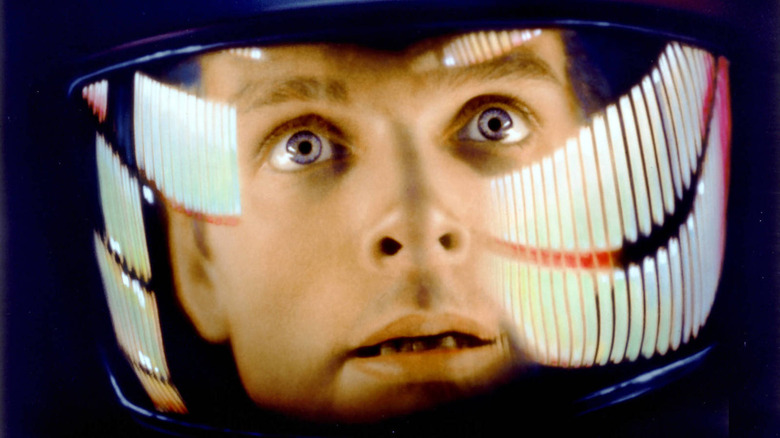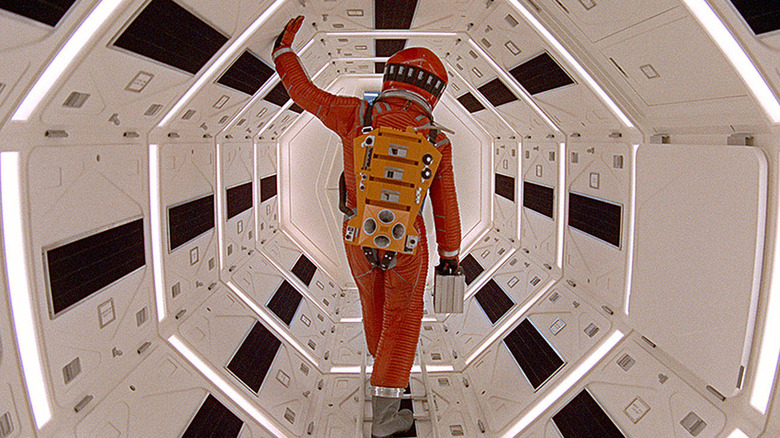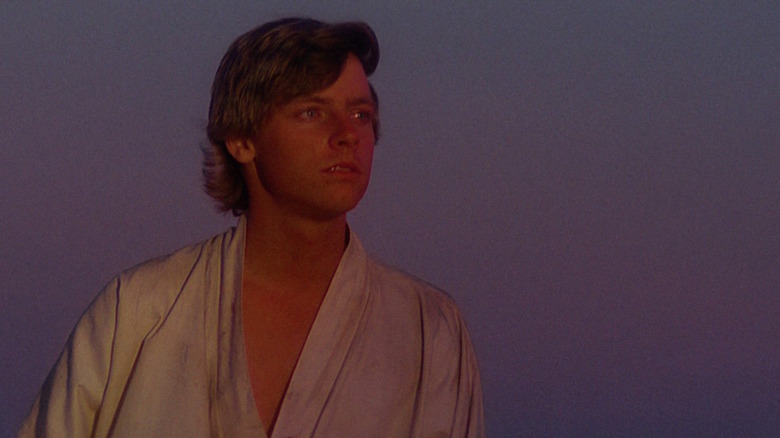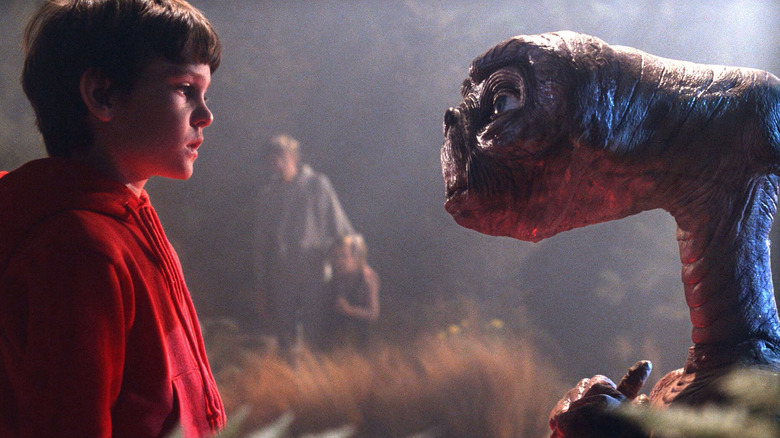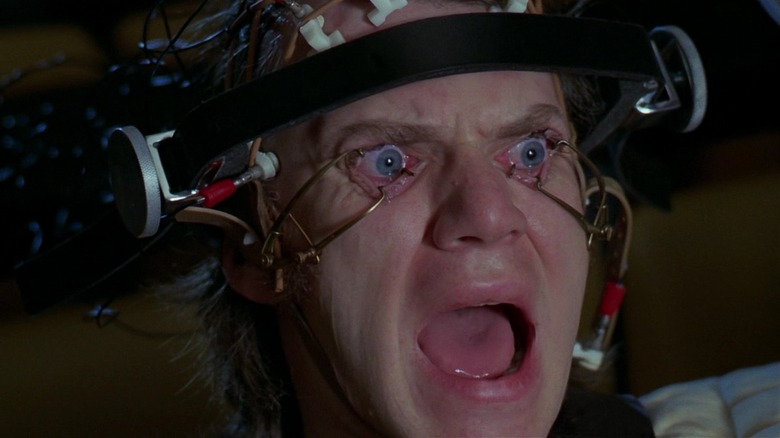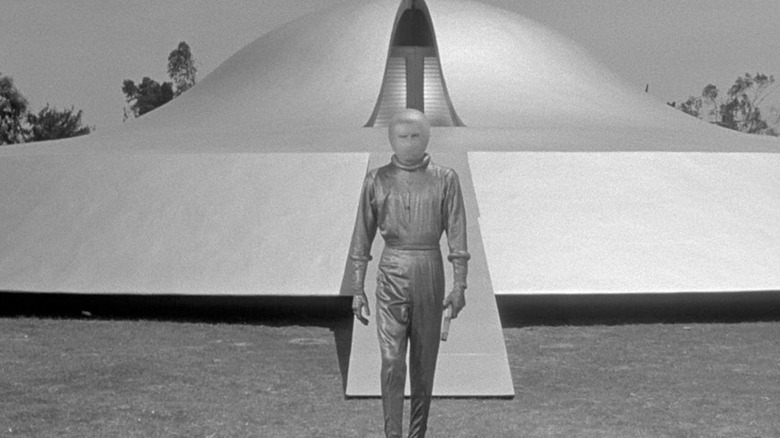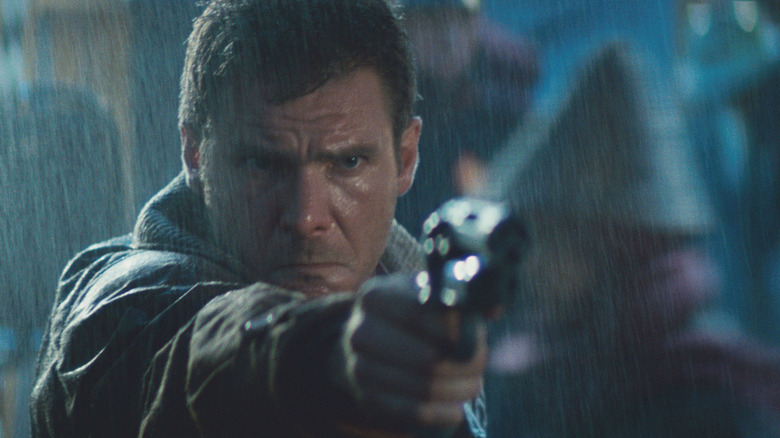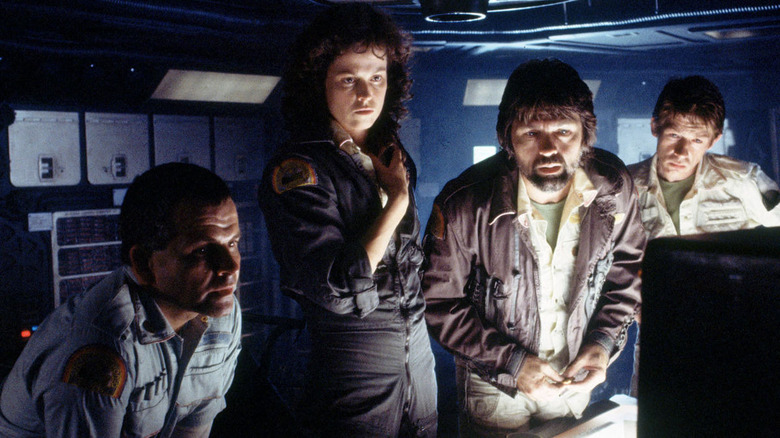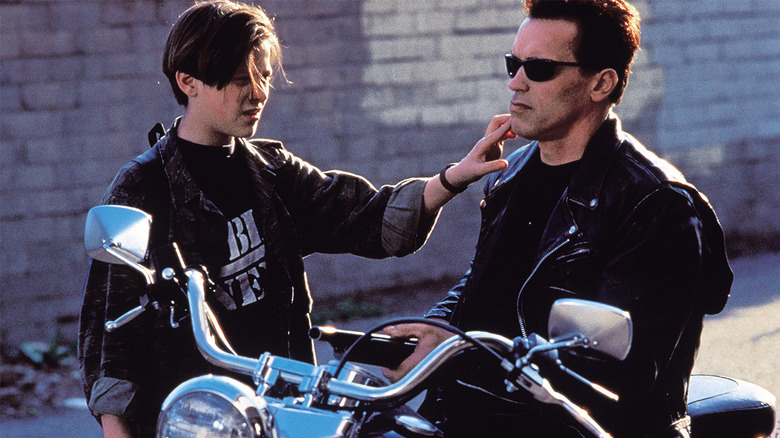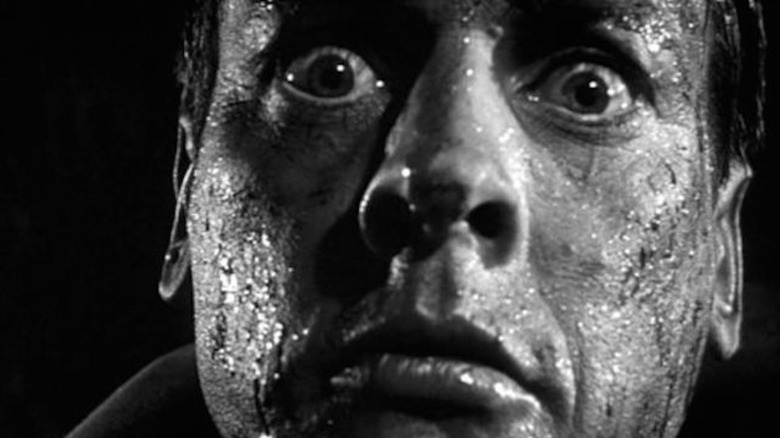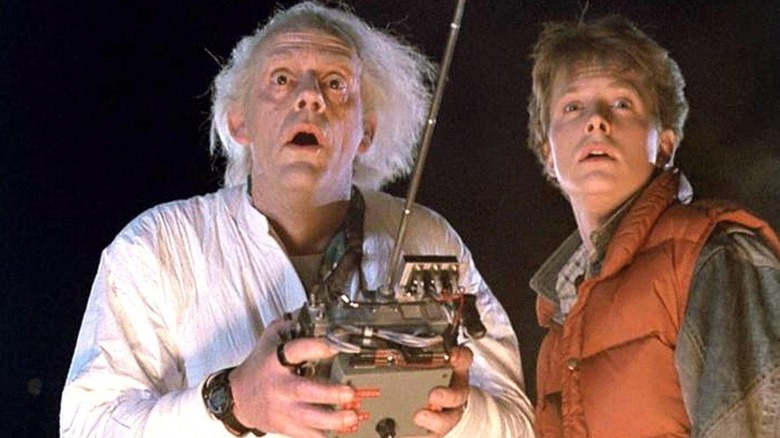The Top 10 Sci-Fi Movies According To The AFI
Films are the perfect form of escapism and, in the case of sci-fi movies, can take us to a different world altogether. Whether they are exploring a dystopian futuristic vision of Earth, taking us to planets and galaxies unknown, or holding up a lens to the wonders and perils of technology, science fiction films frequently offer something unexpected.
Georges Méliès' "A Trip to the Moon," released in 1902, is often cited as the first sci-fi film, and since then the genre has continued to grow both in popularity and ambition. In 2021, Denis Villeneuve's "Dune" proved to be a huge success at the box office, demonstrating that sci-fi films continue to be a draw for audiences.
The American Film Institute (AFI) defines science fiction as "a genre that marries a scientific or technological premise with imaginative speculation." With a plethora of films spanning 120 years to choose from, it can be difficult to pick out the very best. Fortunately, AFI has got you covered: These are their top 10 science fiction movies.
2001: A Space Odyssey (1968)
As outlined in The Hollywood Reporter, "2001: A Space Odyssey" was hugely polarising upon its release. Where some — like Los Angeles Times critic Charles Camplin — called it the "ultimate statement of the science-fiction film," others just didn't get it, and 250 people reportedly walked out of the New York premiere. Discussed and debated for more than 50 years, "2001: A Space Odyssey" is now considered a great cinematic achievement that continues to influence the genre today.
Hugely ahead of its time, Stanley Kubrick's sprawling magnum opus takes us from the "Dawn of Man" to "Beyond the Infinite," in a film that is steeped in unforgettable imagery and thematic richness. Charting a mysterious black monolith through space and time, the film's most memorable segment is the Jupiter mission, where we're introduced to one of cinema's best villains — the sinister AI computer called HAL 9000. Parodied in everything from "The Simpsons" to "WALL-E," the influence of "2001: A Space Odyssey" can be seen throughout pop culture.
It also inspired a generation of filmmakers, with directors such as George Lucas calling it "hugely inspirational" in this featurette on its legacy. More than anything, it proves that science fiction can be intellectual and contemplative, paving the way for films like "Blade Runner," "Interstellar," and "Arrival." "2001: A Space Odyssey" stacks up against non-genre films as well, with AFI placing it 15th on their "100 Years 100 Movies" list.
Star Wars (1977)
Long before the prequels, the sequels, and all the spin-off TV series, there was just "Star Wars." When it arrived in 1977, no one could've expected it to take off in the way that it did. According to The Hollywood Reporter, director George Lucas had originally hoped to make a "Flash Gordon" movie. When he was unable to obtain the rights, he decided to make his own space opera instead, and "Star Wars" was born.
Focusing on young Jedi-in-training Luke Skywalker (Mark Hamill) and his quest to save the galaxy from the evil Darth Vader (voiced by James Earl Jones), "Star Wars" opened to rave reviews from critics, including Vincent Canby of the New York Times who called it "the most elaborate, most expensive, most beautiful movie serial ever made."
The "Skywalker Saga" now spans nine films, but in 1977, a sequel to "Star Wars" — let alone an entire expanded universe — was never a guarantee. Speaking at Tribeca Film Festival in 2015, Lucas admitted that "Star Wars" was a huge risk saying, "I didn't think the film was going to be successful," (via Insider). He was quickly proven wrong when the film grossed over $307 million, becoming the second highest-grossing film of all time when adjusted for inflation.
E.T. the Extra-Terrestrial (1982)
After "Jaws" brought about the modern blockbuster, and "Star Wars" broke its box office record two years later, attention turned to what would come next. In 1982, this was answered by Steven Spielberg with his alien adventure film, "E.T. the Extra-Terrestrial." The film made a whopping $359 million worldwide, surpassing "Star Wars" and holding the top slot until Spielberg eclipsed himself 11 years later with "Jurassic Park."
Following "Close Encounters of the Third Kind" in 1977, Spielberg's fascination with the genre continued, leading him to make "E.T." Speaking to James Cameron for his series "AMC Visionaries: James Cameron's Story of Science Fiction," Spielberg said, "When I was shooting 'Close Encounters' I did the scene of the little alien coming out of the mothership... I thought, 'Wait a second — what if that alien doesn't go back up into the ship, what if he stayed behind?'" (via People) and the idea for "E.T." was born. In the same conversation, Spielberg mentioned the personal inspiration for "E.T.," explaining it was "never meant to be a movie about an extra-terrestrial ... it was supposed to be a movie about my mom and dad getting a divorce."
With its unforgettable score and charming story of a boy's friendship with an alien, "E.T." quickly became a beloved classic. Even now, the power of this nostalgic, heart-warming film ensures it will continue to be adored for generations to come.
A Clockwork Orange (1971)
Not all of the films on this list were well-received on their initial release – Roger Ebert described "A Clockwork Orange" as "an ideological mess" in his scathing two-star review. Stanley Kubrick's film earned notoriety in the 1970s when its glamorization of violence was reported to be the inspiration for a series of "copycat crimes," and its vilification in the press led the director to withdraw the film following its theatrical run. Largely unavailable for almost three decades, the intrigue surrounding the film grew, and by the time it was released following Kubrick's death in 1999, it had amassed a huge cult following.
"A Clockwork Orange" has a timeless quality to it: With its dystopian time period never made clear, there is a sense of ambiguity, and the distinctive retro-futuristic aesthetics mean it could be positioned in either the past, present, or future. Through the character of Alex (Malcolm McDowell), a charismatic yet dangerous young man, the film examines whether a person can be cured of their violent tendencies and the role that the nature vs. nurture debate might play in this. "A Clockwork Orange" is undeniably bleak, but its themes of youth disenfranchisement, government control, and the power and influence of technology, music, and imagery make it still relevant today.
The Day The Earth Stood Still (1951)
The oldest film on the list may be dated by its special effects, but it has a message that is surprisingly potent today. Released in 1951, "The Day The Earth Stood Still" is notable for being one of the few sci-fi films of the time to show alien visitors in a positive light, with the humanoid extraterrestrial Klaatu (Michael Rennie) and robot Gort (Lock Martin) arriving on Earth with a cautionary message about the dangers of war.
Set amidst the Cold War, the film accurately depicts the suspicion and distrust between people, as well as more overtly criticizing the destructive use of nuclear weapons. Steeped in allegory, the savior-like Klaatu arrives with the proclamation that he has "come to visit you in peace and with goodwill." Much of society responds with fear and violence, and — in the case of the politicians — complete ineptitude when it comes to organizing themselves to meet with Klaatu.
The influence of this film can be seen in films such as "Close Encounters of the Third Kind" and "Arrival," with the shared messages of openness to the unfamiliar and the importance of communication. Klaatu's closing speech is powerful, the ending of the film deliberately open-ended: He leaves us with the choice of "join us and live in peace, or pursue your present course and face obliteration" — a sentiment for our times as well as theirs.
Blade Runner (1982)
Box office numbers aren't always the fairest assessment of a film's success, and that is certainly the case with "Blade Runner," which was considered to be a flop when it was released. As is the case with many sci-fi films, the popularity of "Blade Runner" only grew in time: It is now widely considered one of the greatest sci-fi films ever made.
Director Ridley Scott's subsequent new cuts and re-releases of the film ensured it stayed in the public conscience, with new generations of sci-fi fans perpetually re-discovering it. Praised for its high-tech production design, "Blade Runner's" unique neo-noir vision was also hugely influential, inspiring films such as "Ghost in the Shell" and "The Matrix."
A core theme of "Blade Runner" is what it means to be human. For decades, there has been a lingering question of whether the protagonist Rick Deckard (Harrison Ford) — who hunts down and kills replicants — is a replicant himself. What separates a good sci-fi film from a great sci-fi film can often be the richness of the story and themes, and "Blade Runner" — along with its sequel "Blade Runner 2049" — has extraordinary depth, ensuring it will continue to be analyzed for years to come.
Alien (1979)
As the famous tagline of "Alien" informs us, "In space, no one can hear you scream." And with that ominous warning, this unforgettable film delivers one of the best examples of genre-bending, with its perfect blend of science fiction and horror. Inspiring awe and wonder, there is nonetheless something frightening about the emptiness and vastness of space, and that is something "Alien" expertly taps into.
The film follows the spaceship Nostromo and the terror that unfolds when a crewmember is attacked by a mysterious and horrifying lifeform. Even if you're not familiar with the film, chances are you will know the infamous "chest-burster" scene, where the alien unexpectedly erupts from Kane's (John Hurt) torso. Using incredible practical effects, director Ridley Scott deliberately chooses to keep the finer details of the scene a secret from even the rest of the cast, resulting in their reactions being entirely genuine — Veronica Cartwright even passed out when the fake blood hit her in the face (via The Guardian).
"Alien" also birthed a cinematic icon with the character of Ripley (Sigourney Weaver). Frequently hailed as one of the best movie characters of all time, the AFI acknowledged Ripley's influence by placing her 8th on their 100 Heroes and Villains list. Further testament to this film's (and the character's) popularity, Weaver secured an Oscar nomination for best actress for the sequel "Aliens" — hugely significant, as performances in sci-fi or horror films are rarely recognized.
Terminator 2: Judgment Day (1991)
Released seven years after the original, "Terminator 2: Judgment Day" (also promoted as "T2") is a groundbreaking film, and still one of the greatest sequels of all time. Where the first film positioned Arnold Schwarzenegger's Terminator as the film's villain, "T2" flips the script and makes him the hero. Reprogrammed in the future, the Terminator is sent back in time to protect humanity's savior John Connor (Edward Furlong) from the malevolent T-1000 (Robert Patrick).
"T2" was, at the time, the most expensive film ever made with a budget of around $100 million, largely due to the innovative special effects. The "liquid metal" effect required for the shapeshifting T-1000 remains one of the seminal moments in the advancement of CGI technology and holds up remarkably well more than 30 years after the film's release. As well as being adored by fans, "T2" also enjoyed awards success, winning four Oscars, including best visual effects.
"T2" is also one of the most quotable sci-fi blockbusters, with lines such as "Hasta la vista, baby" becoming part of the larger cultural zeitgeist. "T2" was not only a huge box office hit, making over $500 million worldwide, but a critical success, with Joe Brown of the Washington Post calling it "brutally beautiful, darkly comic sci-fi."
Invasion of the Body Snatchers (1956)
The beauty of 1956's "Invasion of the Body Snatchers" is that we see very little of the extraterrestrial invaders, yet the feeling of suspicion and paranoia is palpable. With heavy film noir influences, this version doesn't lean so far into the body horror of the 1978 remake, yet it is no less terrifying, proving that so often the scariest things can be those closest to home.
Set in the fictional California town of Santa Mira, Dr. Miles Bennell (Kevin McCarthy) begins to receive numerous reports from the townspeople that their relatives have been replaced by identical-looking imposters. When Dr. Bennell and his former flame Becky (Dana Wynter), find some strange seedpods, they discover the horrifying truth that the townspeople are being replicated and destroyed by the alien invaders.
The idea of "alien" entities walking undetected amongst us has extra relevance when you consider the time this film came out. While not overtly addressing real-world politics, the film offers timely commentary on McCarthyism and the post-war paranoia that existed in America in the time of the Cold War — particularly the fear of increased communist espionage.
Walking a fine line between sci-fi and horror, "Invasion of the Body Snatchers" is a masterclass in creeping dread and tension. Where most alien invasion films would have us looking outwardly, this film has us taking a long hard look at ourselves and those around us.
Back to the Future (1985)
Few films prove to be as much of a pop-culture touchstone as "Back to the Future." However, the road to making "Back to the Future" wasn't an easy one, with the idea being "rejected over 40 times" (via Esquire) before it was finally greenlit by Universal. The problems didn't end there and a costly late casting change for the lead role of Marty McFly caused further delays. Fortunately, the stars aligned eventually and the studio got their first choice for Marty — Michael J. Fox.
Combining time travel with a teen comedy, the film sees Marty transported from the year 1985 to 1955, aided by the eccentric scientist Doc Brown (Christopher Lloyd). When Marty inadvertently disrupts his parents' initial meeting, putting himself and his siblings' very existence at risk, he must act swiftly to bring them together and, well ... get back to the future.
"Back to the Future" was not only a critical and commercial success — becoming the highest-grossing film of 1985 – but it quickly became a genuine phenomenon, spawning two successful sequels as well as an animated spin-off series, video games, merchandise, and theme park rides. Now approaching 40 years since its release, it is still considered one of the greatest sci-fi films ever made.
